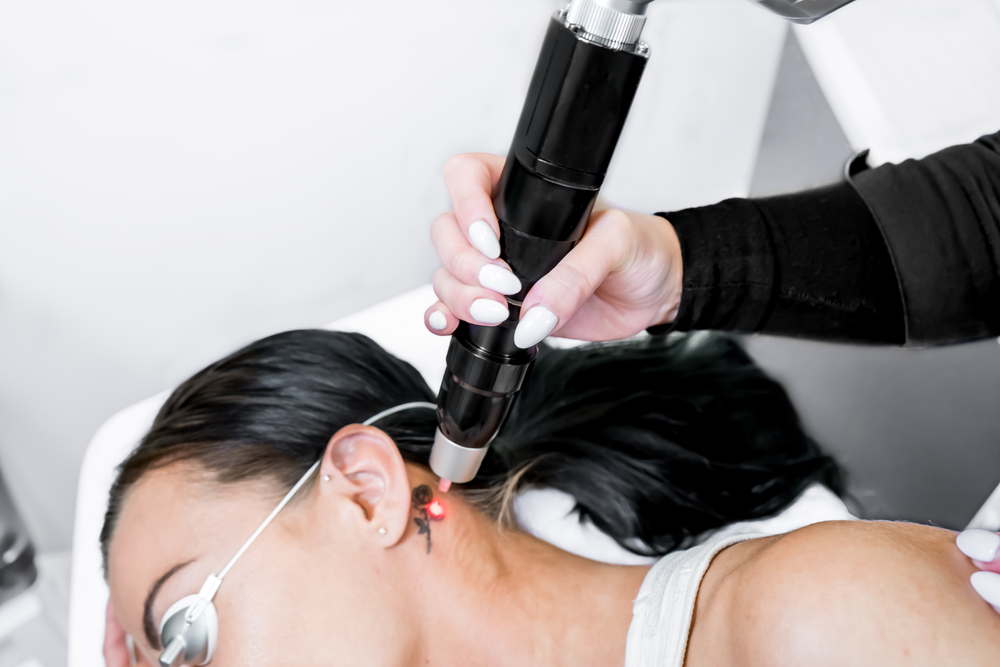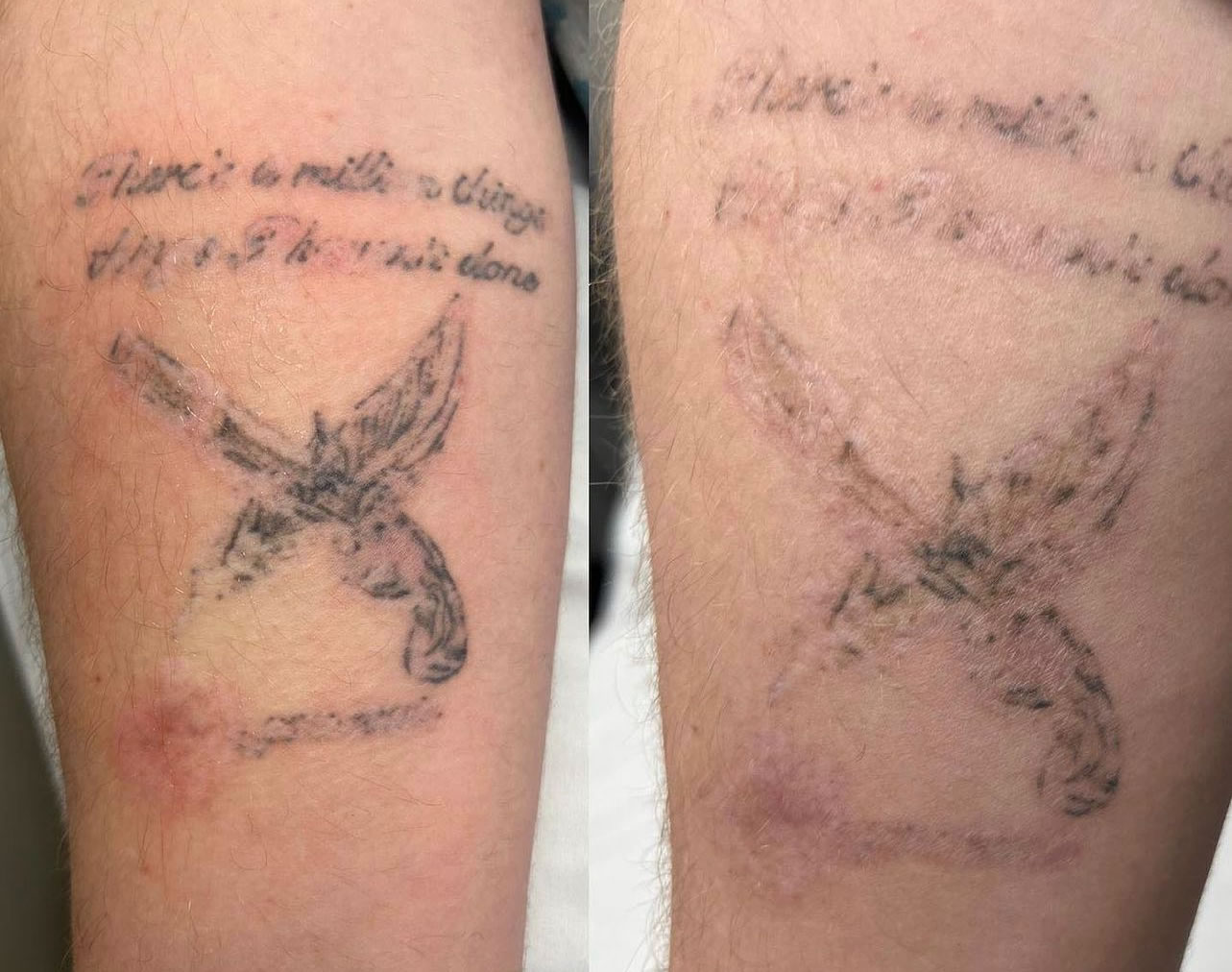
Several tattoo removal methods can lighten or remove unwanted ink. Each method varies in effectiveness, cost, and potential side effects. Here are the most commonly used tattoo removal methods:
Laser tattoo removal is the most popular and effective method to remove unwanted tattoos. Here is a step-by-step guide to the laser tattoo removal process.
Before beginning the laser tattoo removal process, a consultation is essential. The tattoo removal specialist will examine the tattoo’s size, age, and location and evaluate the patient’s skin type to determine how many laser treatments are required. They will also examine the tattoo ink’s color to determine which type of laser is best for the process.
High-intensity laser light is directed onto the tattooed skin during laser tattoo removal. The laser light passes through the skin and is absorbed by the tattoo ink. The laser light breaks the ink into tiny particles that the body’s immune system can remove naturally.
The number of laser sessions required for complete tattoo removal varies, depending on the tattoo’s size, age, location, and color. It typically takes between six and ten laser sessions for complete tattoo removal.
After laser treatment, the tattooed skin may experience swelling, redness, and blistering. These side effects are temporary and subside after a few days.
After the laser tattoo removal, you must properly care for the treated area. Avoid excessive sun exposure and apply antibiotic ointment to prevent infection.
The laser tattoo removal process effectively removes tattoos over time. The results may vary depending on the tattoo’s color, age, location, and other factors. Most patients see significant results after several laser treatments.
The laser tattoo removal is a safe and effective method for removing unwanted tattoos. It is essential to consult with a qualified tattoo removal specialist to determine the number of laser treatment sessions required and properly care the treated area after the treatment. If you want to remove a tattoo, consider the laser tattoo removal process for the best results.
Several factors critical to achieving optimal results determine the success of tattoo removal.
The color of the ink used in tattoos can also play a significant role in removal success. Darker colors, like black or dark blue remove tattoo, are generally easier to remove than lighter colors, like pink or yellow. In addition, tattoos that use a mix of colors may require longer treatment times or more sessions to achieve the desired results.
The age and location of the tattoo can also impact removal success. Older tattoos that have faded over time may be easier to remove than newer, more vibrant designs. The location of the tattoo on the body can also influence treatment outcomes. Tattoos on areas with more blood flow, such as the face or fingers, tend to take longer to remove due to the increased immune response in these regions.
Finally, skin type can impact tattoo removal success. Individuals with lighter skin tones tend to have better results from laser tattoo removal because the contrast between the ink and skin is more apparent. Those with darker skin tones run a higher risk of skin damage or discoloration during the removal process. It is important to consult a qualified dermatologist or tattoo removal professional to determine the most effective treatment plan for each case.
The number of sessions the tattoo removal undergoes largely determines its success. Multiple sessions are necessary to ensure that the ink is removed completely. Factors such as the size, depth, and color of the tattoo may also impact the number of sessions needed for successful removal. Depending on these factors, the number of sessions needed may vary, with some tattoos requiring a few sessions while others taking several months to remove.
The process can be lengthy and require several sessions, but patience is vital to achieve successful results. Rushing through the process or seeking shortcuts, such as attempting to remove a tattoo in one session, may cause significant damage to the skin and result in unsatisfactory results.
It’s important to keep the treated area clean and dry for the first few days following the procedure to avoid infection. Avoid submerging the treated area in water, by swimming, bathing, or soaking in a hot tub.
After the procedure, applying ice packs can help reduce swelling and bruising. Wrap the ice pack in a clean towel and hold it against the treated area for 10–15 minutes.
Avoid touching or scratching the treated area to avoid infection, scarring, and other complications. If itching is an issue, gently pat the area but avoid scratching it.
After the procedure, avoid direct exposure to the sun. Excessive sun exposure can worsen swelling, redness, and blistering.
Your tattoo removal professional may advise you to apply healing ointment to the treated area. To reduce the risk of infection and promote healing. Follow your professional’s instructions and apply the ointment as directed.
Wear loose-fitting, breathable clothing over the treated area to avoid irritation. Tight clothing can rub against the treated area and cause discomfort, irritation, and infection.
It’s essential to keep in touch with your tattoo removal professional and follow up as recommended. They can monitor your progress and address any issues that may arise.
Following these aftercare instructions can optimize your tattoo removal results and promote a safe and successful healing process.


PHONE:
(801) 447-1859
LOCATION:
2797 N HIGHWAY 89 #100,
Ogden, Utah 84404
HOURS:
Mon - Fri : 9:00AM - 5:00 PM
Sat & Sun: Closed